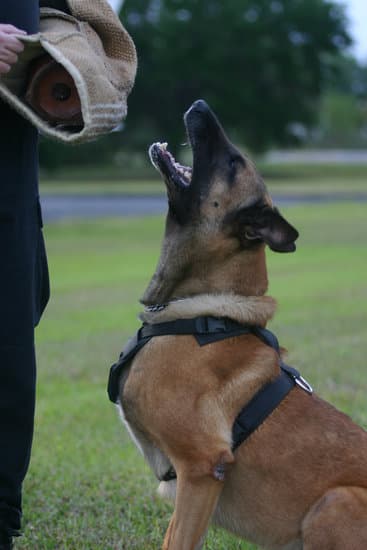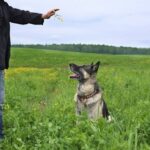Have you ever wondered how do you train a dog to leash? Leash training is an essential skill for any dog owner, as it provides safety and control when taking your furry friend for a walk. In this article, we will explore the importance of leash training for dogs and provide valuable tips on how to effectively train your dog to walk nicely on a leash.
Understanding your dog’s behavior and body language is crucial when it comes to leash training. By learning to interpret your dog’s cues, you can address any underlying issues that may be contributing to their behavior while on a leash. Additionally, choosing the right leash and collar for training is important for ensuring your dog’s comfort and safety during walks.
Positive reinforcement training methods have been proven to be effective in teaching dogs how to walk nicely on a leash. By rewarding good behavior with treats or praise, you can encourage your dog to follow commands and behave appropriately while on a leash. In the following sections, we will delve into the specifics of positive reinforcement training and provide valuable tips for addressing common challenges that may arise during leash training.
Understanding Your Dog’s Behavior and Body Language
Understanding Canine Body Language
Dogs communicate through their body language, and it’s essential for owners to be able to decipher what their dog is trying to convey. For leash training, it’s important to pay attention to signs of stress or excitement.
A dog that is pulling on the leash or jumping around may be overly excited, while a dog that is cowering or trying to back away may be feeling stressed. Understanding these signals will help you tailor your training approach to effectively address your dog’s needs.
Behavioral Factors to Consider
When it comes to leash training, understanding your dog’s behavior is crucial for success. Different dogs have different predispositions when it comes to leash walking. For instance, some breeds have a strong prey drive and may become easily distracted by squirrels or other small animals while on a walk.
Other dogs may exhibit fear or aggression towards other dogs or people, making leash walking a challenging experience. By taking into account these behavioral factors and addressing them appropriately, you can ensure a more positive and successful leash training experience for both you and your dog.
Patient Observation and Adaptation
Effective leash training requires patience and flexibility from the owner. By observing your dog’s behavior closely during walks, you can identify any issues or areas for improvement in the training process.
This could include noticing triggers that cause your dog to pull on the leash or become reactive towards certain stimuli. Once these issues are identified, you can adapt your training methods accordingly and gradually work on desensitizing your dog to those triggers through positive reinforcement techniques such as treats and praise.
Choosing the Right Leash and Collar for Training
When it comes to leash training for your dog, choosing the right leash and collar is essential to ensure both comfort and safety for your pet. The type of leash and collar you select can make a significant impact on the success of your training efforts.
First, consider the size and breed of your dog when choosing a leash. For smaller dogs, a lightweight and shorter leash may be more appropriate, while larger breeds may require a stronger and longer leash for better control. Additionally, retractable leashes can provide more freedom for your dog during walks but may not be suitable for training purposes, as they can easily become tangled or cause injuries if used improperly.
In terms of collars, there are various options available such as flat collars, martingale collars, head halters, harnesses, and more. It’s important to select a collar that fits properly and is comfortable for your dog to wear. A well-fitted collar should allow you to slip two fingers underneath without being too loose or too tight.
Ultimately, the right leash and collar for training will depend on your dog’s individual needs and behavior. It’s worth experimenting with different options to see what works best for both you and your furry companion.
| Leash Type | Recommended Breed Size |
|---|---|
| Standard Leash | Medium to Large Breeds |
| Retractable Leash | All Sizes (for controlled environments) |
| Harness | All Sizes (especially for dogs prone to tracheal damage) |
Positive Reinforcement Training Methods for Leash Walking
Using positive reinforcement is an effective way to train your dog to walk nicely on a leash. This method involves rewarding and praising your dog for good behavior, rather than using punishment for bad behavior. Positive reinforcement can help create a strong bond between you and your dog, making the training process more enjoyable for both of you.
One way to use positive reinforcement when leash training your dog is to offer treats as rewards for walking nicely on the leash. Start by taking short walks with your dog and give them a treat each time they walk without pulling on the leash. This will teach them that staying close to you and walking calmly results in something positive.
In addition to using treats, verbal praise and petting can also be powerful forms of positive reinforcement. When your dog walks politely on the leash, use a happy tone of voice to praise them and give them gentle pats or scratches as a reward. This positive feedback will encourage them to continue behaving well during leash walks.
| Positive Reinforcement Training Methods | Benefits |
|---|---|
| Using treats as rewards | Teaches dogs that good behavior leads to something positive |
| Verbal praise and petting | Creates a strong bond between owner and dog |
Teaching Your Dog to Walk Nicely on a Leash
Understanding the Basics
Before you start leash training your dog, it’s important to understand the basics of how to properly handle the leash and communicate with your furry friend. A key aspect of leash training is to ensure that your dog understands that walking on a leash is a cooperative activity between the two of you. This means understanding the proper way to hold the leash, maintain a relaxed grip, and avoid allowing tension in the leash.
Introducing Distractions
Once your dog has mastered walking on a leash in calm environments, it’s time to gradually introduce distractions such as other people, animals, or busy streets. Begin by exposing your dog to mild distractions and use positive reinforcement techniques such as treats or praise when they respond well. The goal is to gradually increase the level of distraction while still maintaining control over your dog’s behavior on the leash.
Consistency Is Key
One of the most important aspects of teaching your dog to walk nicely on a leash is consistency. This means using the same commands and training techniques every time you go for a walk. It also means being patient and understanding that leash training takes time and practice. By consistently reinforcing good behavior and gently correcting unwanted behavior, you can help your dog learn how to walk nicely on a leash in various environments.
By following these tips and being patient with your furry friend, you can successfully teach them how to walk nicely on a leash. Remember that every dog is different, so it’s essential to adapt your training methods based on your dog’s individual needs and personality. With dedication and positive reinforcement, both you and your dog can enjoy pleasant walks together.
Addressing Common Leash Training Challenges
Leash training a dog can be a challenging process, and many owners encounter common problems along the way. Addressing these challenges is essential to ensure that your dog becomes comfortable and well-behaved when walking on a leash. Here are some of the most common leash training challenges and how to overcome them:
1. Pulling on the Leash: One of the most common challenges in leash training is dealing with a dog that constantly pulls while walking. This behavior can make walks frustrating and unpleasant for both you and your dog.
To address this issue, consider using a front-clip harness or head halter, which can help reduce pulling by giving you more control over your dog’s movements. Additionally, using positive reinforcement techniques, such as rewarding your dog for walking nicely beside you, can encourage good leash manners.
2. Reactivity to Other Dogs or People: Some dogs may become reactive or aggressive towards other dogs or people while on a leash. This behavior can be not only concerning but also dangerous.
To address this challenge, it’s important to work on desensitizing your dog to the triggers that cause their reactive behavior. Gradually exposing your dog to other dogs or people at a distance and rewarding them for calm behavior can help them associate positive experiences with these situations.
3. Fear of the Leash: Some dogs may develop a fear or aversion to the leash itself, making it difficult to even get them out for a walk.
If your dog shows signs of fear or anxiety when you bring out the leash, it’s important to take things slow and gradually desensitize them to it. You can do this by leaving the leash out in an area where your dog spends time and pairing it with positive experiences, such as treats or playtime.
By addressing these common challenges in leash training, you can set your dog up for success and enjoy pleasant walks together.
Tips for Consistent and Successful Leash Training
Leash training is an essential part of ensuring that your dog can safely and comfortably go for walks with you. Consistency and patience are key when it comes to successfully leash training your dog. Here are some tips to help you achieve consistent and successful leash training with your furry friend:
- Start Early: It’s best to start leash training your dog as early as possible, ideally when they are still a puppy. This allows them to form positive associations with the leash and helps prevent any bad habits from forming.
- Use Positive Reinforcement: When your dog exhibits the desired behavior on the leash, such as walking calmly by your side, be sure to reward them with treats, praise, or their favorite toy. This positive reinforcement will encourage them to continue behaving well on the leash.
- Stay Patient and Calm: Dogs can pick up on their owner’s emotions, so it’s important to remain patient and calm during leash training. If you become frustrated or stressed, it can make the training process more difficult for both you and your dog.
Consistency is key when it comes to successful leash training for dogs. By following these tips and staying committed to the training process, you can ensure that your dog walks nicely on a leash and enjoys going for walks with you.
Remember that every dog is unique, so it’s essential to tailor your approach based on your pet’s individual needs and behavior. With time and dedication, you can build a strong bond with your dog while mastering the art of leash walking together.
Maintaining Leash Training and Building a Strong Bond With Your Dog
In conclusion, leash training is a crucial aspect of a dog’s obedience and safety. It is not only about teaching them to walk nicely on a leash but also about building a strong bond with your furry friend.
Understanding your dog’s behavior and body language is essential in effectively training them to be well-behaved on a leash. By choosing the right leash and collar for training, you can ensure that your dog is comfortable and responsive during the training process.
Positive reinforcement training methods play a significant role in leash walking, as they encourage good behavior and make the training experience more enjoyable for both you and your dog. Addressing common leash training challenges, such as pulling or distractions, requires patience and consistency. By implementing tips for consistent and successful leash training, you can establish good habits that will benefit both you and your dog in the long run.
Ultimately, maintaining leash training goes beyond just teaching your dog to walk nicely on a leash; it is about strengthening the bond between you and your pet. Building trust, communication, and understanding through consistent training not only establishes good manners but also deepens the connection between you and your furry companion.
So, next time someone wonders how do you train a dog to leash, remember that it’s not just about physical control but also about developing a meaningful relationship with your beloved pet.
Frequently Asked Questions
What Is the Fastest Way to Leash Train a Dog?
The fastest way to leash train a dog is through positive reinforcement and consistency. Using treats and praise to reward good behavior, along with regular, short training sessions can help your dog learn quickly.
How Do I Train My Dog to Walk on a Leash Without Pulling?
To train your dog to walk on a leash without pulling, start by teaching them basic obedience commands like “heel” and “leave it.” Use treats to reward them for walking calmly by your side, and be patient as they learn.
How Do You Teach a Dog to Be on a Leash?
Teaching a dog to be on a leash involves gradually getting them used to wearing the leash and being guided by it. Start by letting them wear the leash around the house, then move on to practicing in a quiet outdoor area before venturing into busier environments.

Welcome to the blog! I am a professional dog trainer and have been working with dogs for many years. In this blog, I will be discussing various topics related to dog training, including tips, tricks, and advice. I hope you find this information helpful and informative. Thanks for reading!





